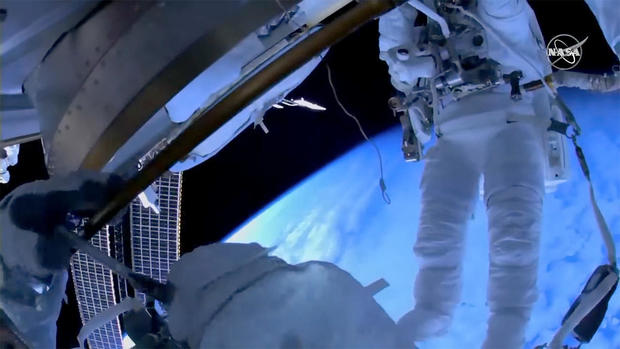21.01.2023
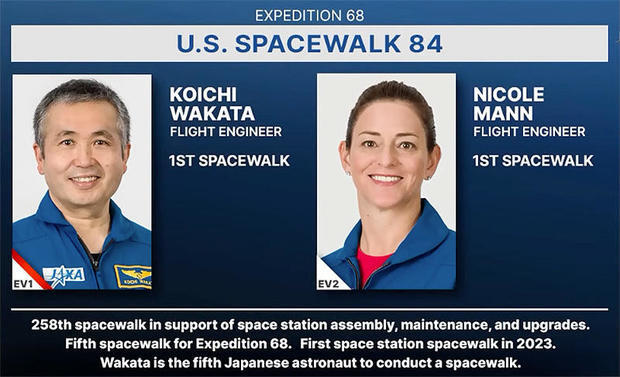
Two astronauts making their first spacewalk ventured outside the International Space Station on Friday amid heightened awareness of the threat posed by micrometeoroids and space debris in the wake of an impact that damaged a Russian crew ferry ship last month.
While the odds of a life-threatening impact during a spacewalk are low — on the order of 1-in-23,600 — the threat is "something that I think very much about in preparation for any EVA," said Keith Johnson, a NASA mission control spacewalk officer.
"The suit is designed to accommodate ... certain size puncture holes and yet still keep the crew members alive," he added. But "there's always risk."
Floating in the Quest airlock, Japanese astronaut Koichi Wakata and NASA's Nicole Mann switched their spacesuits to battery power at 8:14 a.m. EST to kick off a seven-hour and 21-minute excursion. They made their way outside a few minutes later.
They spent the day working on the right side of the space station's power truss, completing assembly of a Tinkertoy-like solar array support bracket and building a second bracket from scratch. One strut could not be attached, and its installation was deferred to an upcoming spacewalk.
Spacewalkers already have attached three ISS roll-out solar arrays, known as IROSAs, on brackets assembled on the left side of the power truss and one more IROSA on the right. Two additional roll-out arrays will be launched later this year for installation on the brackets Wakata and Mann are assembling.
The goal is to augment the electrical output of the space station's original set of solar arrays, which have degraded over their years in the harsh space environment. When the IROSA upgrade is complete, the lab will be back to full power.
Friday's spacewalk came a little more than a month after a micrometeoroid impact ruptured a coolant line on a Russian Soyuz crew ferry ship December 14, rendering it unusable for a planned crew return in March.
Instead, the Russians will launch a fresh Soyuz without a crew on February 20 to take the place of the damaged spacecraft. The crew of the damaged MS-22 ferry ship — two cosmonauts and a NASA astronaut — now will spend an additional six months in space before coming home in September.
The impact served as a reminder that astronauts and cosmonauts conducting spacewalks in the vacuum of low-Earth orbit, an environment populated by countless undetectable particles whizzing about at extreme velocities, face a small but very real threat.
NASA experts carry out a probabilistic risk assessment for micrometeoroids and space debris impacts before every spacewalk based on the latest assessment of the environment, where the astronauts will be working and a variety of other factors, including the timing of known meteor showers.
For the most recent spacewalk last month, the calculated odds of a spacesuit penetration during a six-and-a-half-hour EVA were in the neighborhood of 1-in-3,800. The odds of a "critical" penetration were on the order of 1-in-21,300. The numbers for Friday's spacewalk were similar, an official said.
In this case, "critical" means a penetration larger than 4 millimeters across resulting in an uncontrollable loss of oxygen. The micrometeoroid that damaged the Soyuz spacecraft was about 1 millimeter across.
Safety tethers and procedures are in place to enable a speedy return to the safety of the space station airlock in case of a life-threatening problem. The goal is to get back inside in 30 minutes or less.
As for impacts, the multi-layer spacesuit is designed to help ensure a smaller particle will break up during impact, before it can penetrate the innermost layer and allow air to escape.
But there are many unknowns in the calculation and despite extensive training and contingency plans, "it's just like anytime you get in an automobile, there is always risk," Johnson said.
"But we need to be willing to figure out the safest way to do it, get ready for all that could go wrong and that's how we do it to put our crew members in that position."
Quelle: CBS News
+++
Astronauts complete spacewalk to prep for new ISS solar arrays
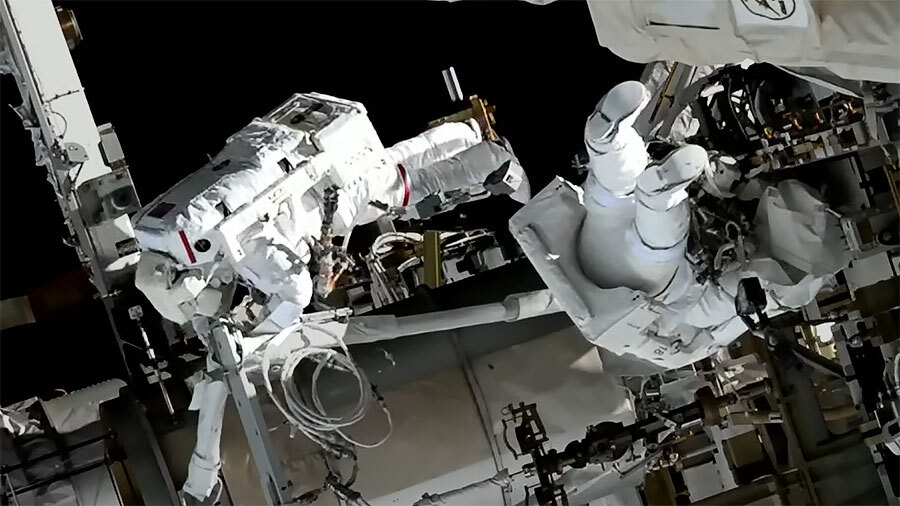
Astronauts Koichi Wakata (left) and Nicole Mann (right) outside the International Space Station on Friday’s spacewalk. Credit: NASA
Japanese astronaut Koichi Wakata and NASA astronaut Nicole Mann suited up and floated outside the International Space Station Friday for a spacewalk to prepare the lab for arrival of another pair of new solar arrays later this year.
The astronauts switched their spacesuits to internal battery power at 8:14 a.m. EST (1314 GMT) Friday to mark the official start of the spacewalk, the first of the year at the space station. They floated out of the Quest airlock to begin gathering tools and headed to the starboard, or right, side of the station’s power truss.
Wakata and Mann completed the installation of a mounting bracket near one of the space station’s eight existing solar arrays, associated with power channel 1B. Work on that task began on a previous spacewalk. Then the astronauts began to work on attaching a mounting frame for another solar array on power channel 1A.
The two power channels the astronaut worked on Friday are located on the starboard side of the space station’s solar power truss, which extends the length of a football field. Channel 1B is on the S6 truss section at the far right of the power truss, and Channel 1A is located on the next section inward, called S4.
The mounting frames, called modifications kits, will support the attachment of new roll-out solar arrays to be delivered to the space station later this year on a SpaceX Dragon cargo ship. SpaceX has already launched four of the roll-out solar arrays on two previous Dragon resupply missions in June 2021 and in November 2022.
Wakata and Mann finished most of the work to install the modification kit on channel 1B, but due to time constraints, ground teams instructed the astronauts to head back to the airlock before they could finish tightening a bolt on the final strut for the second mounting bracket. That task will be completed on a future spacewalk.
The astronauts began repressurizing the Quest airlock at 3:35 p.m. EST (2035 GMT), marking the end of the 7-hour, 21-minute spacewalk.
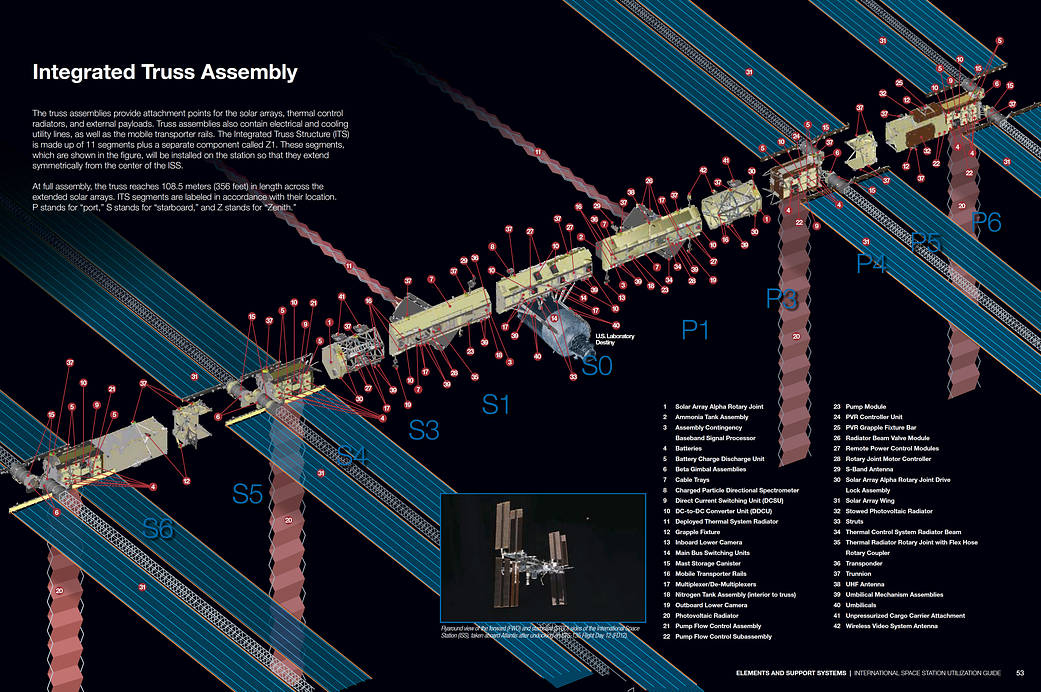
The spacewalk Friday was part of a series of excursions to prepare for and install the new International Space Station Roll-Out Solar Arrays, or iROSA units. The iROSA units are built by Redwire, and are designed to augment the space station’s capability to generate electricity as the efficiency of the lab’s original solar panels declines with age.
NASA wants the mounting frame for each new solar array wing to be installed ahead of time. Then the astronauts go out on spacewalks to attach each new roll-out solar array by hand when they arrive on a SpaceX cargo freighter.
NASA astronauts Frank Rubio and Josh Cassada completed two spacewalks in December to install and unfurl the two newest roll-out solar arrays. Station crew members will perform similar work later this year when SpaceX delivers the final two roll-out solar arrays on a cargo mission tentatively set for launch in June.
The roll-out solar arrays launch wrapped around a spool to fit inside the Dragon spacecraft’s cargo trunk. Once deployed, they stretch about 63 feet long and 20 feet wide (19-by-6 meters), roughly half the length and half the width of the station’s original solar panels. The solar array blanket will deploy at a canted angle relative to the original solar panel on each truss, allowing sunlight to illuminate the new and old arrays.
Despite their smaller size, each of the new arrays generate about the same amount of electricity as each of the station’s existing solar panels.
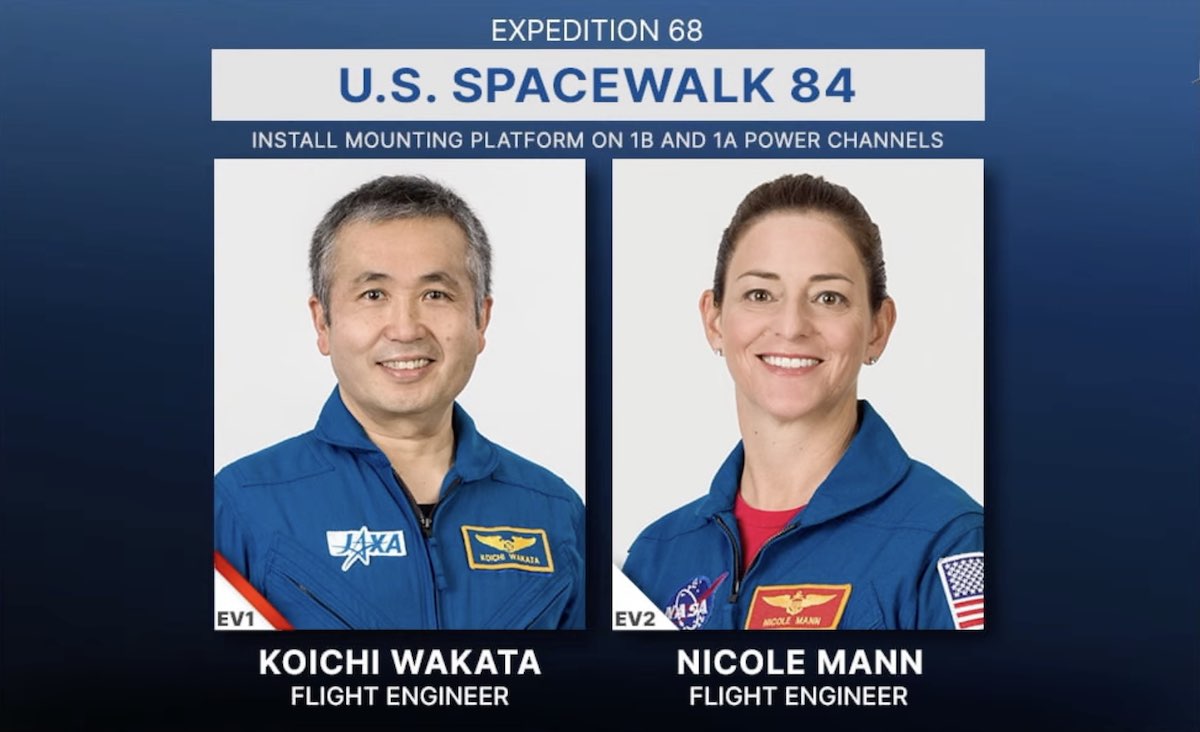
The International Space Station has eight power channels, each fed with electrical power generated from one solar array wing extending from the station’s truss backbone.
The original solar panels launched on four space shuttle missions from 2000 to 2009. As expected, the efficiency of the station’s original solar arrays has degraded over time. NASA is upgrading the space station’s power system with the new roll-out solar arrays — at a cost of $103 million — which will partially cover six of the station’s eight original solar panels.
When all six iROSA units are deployed on the station, the power system will be capable of generating 215 kilowatts of electricity to support at least another decade of science operations. That’s a 30% increase in power generation capability. The enhancement will also accommodate new commercial modules planned to launch to the space station.
The spacewalk Friday was the first in the careers of Wakata and Mann, and the 258th spacewalk overall since 1998 in support of space station assembly and maintenance. Wakata, designated EV1 as the lead spacewalker Friday, is a veteran astronaut on his fifth flight to space. Mann, designated EV2, is on her first spaceflight.
Mann and Wakata launched Oct. 5 on a SpaceX Crew Dragon spacecraft with crewmates Josh Cassada and Russian cosmonaut Anna Kikina. They are scheduled to return to Earth in early March, after the arrival of another team of four astronauts and cosmonauts on SpaceX’s next crew launch.
NASA astronaut Frank Rubio and Russian cosmonauts Sergey Prokopyev and Dmitri Petelin round out the seven-person crew on the International Space Station. They arrived at the space station in September on a Russian Soyuz spacecraft.
Quelle: SN
+++
Astronauts conduct EVA to lay groundwork for final set of iROSA arrays

Astronauts Koichi Wakata and Nicole Mann have conducted a spacewalk to enable the final set of upgraded ISS Roll-Out Solar Array (iROSA) “solar wings” to be installed on ISS sometime this summer.
The astronauts left the Quest airlock module on Friday, Jan. 20, at 7:14 AM CST (13:14 UTC) on US EVA-84. Koichi Wakataa, EV1, wore the suit with the red stripes while Nicole Mann, EV2, wore the suit with no stripes. This is the first spacewalk for both astronauts, and they will use EMUs 3004 and 3009.
After Wakata was done with this task on the S6 truss, he translated over to the S4 truss and worked with Mann on the iROSA kit installation for the 1A power channel. They installed a triangular fitting on top of the Beta Gimbal Assembly (BGA), then four trusses, two on each side of the triangular mount before torquing the bolts to finish the truss installation.
Mann’s next task was to route the cables related to the iROSA mod kit. The cables will be installed when the 1A channel’s iROSA array is installed after it arrives at the ISS. Wakata then completed the iROSA mounting installation for this EVA by routing cables to his side of the mounting bracket.
Mann was then to attach the DC to DC unit (DDCU) jumper cable to two different locations on the starboard truss before following Wakata to the airlock to finish the EVA. The jumper cable will allow autonomous rerouting of power to another electrical box if there is a failure.
However, the jumper cable attachment was left for another EVA as time did not allow it to be completed today.
Possible get-ahead tasks also planned for today involved routing cables on the 1B power channel on the S6 truss. This would require one of the EVA crewmembers to translate near the end of the starboard truss.
Another get-ahead that was considered was the retrieval for refurbishment of a robotic micro conical tool stored on the ISS exterior.
With the tasks scheduled for EVA-84 finished, the way is cleared for the installation of the last two iROSA arrays after they arrive on CRS-28, currently scheduled for no earlier than June 5. Four iROSA arrays are already installed and operational aboard ISS.
Since March 2009, the ISS has been equipped with 16 large solar panels on four truss elements. The original solar panels, designed to last 15 years and generate up to 240 kilowatts (kW) as a whole, have degraded over time due to the radiation environment in low Earth orbit, as expected.
The original panels on the P6 truss have lasted for just over 22 years on orbit, and, being the most degraded, were the first solar wings to be augmented by iROSA arrays. The solar panels on the S6 truss — the last truss segment to be installed on the ISS — are coming up on their 14th year on orbit, just short of their design lifetime.
Before the iROSA upgrade project started, the ISS was generating just 160 kilowatts of power, and these arrays will augment the existing solar panels, restoring the station’s power generating capacity to 215 kW. The first EVA related to the iROSA upgrade occurred in February 2021, with the first two iROSA panels — attached to power channels 2B and 4B on the P6 truss — unfurled nearly four months later.
The second pair of iROSA arrays were installed in late 2022 by Expedition 68 crewmembers Josh Cassada and Frank Rubio. These arrays are on power channels 3A and 4A on the S4 starboard and P4 port truss segments, respectively. The remaining pair of iROSA arrays will be installed on power channels 1A and 1B on the S4 and S6 starboard truss segments.

A diagram of iROSA solar array installation progress on the exterior truss segments on the ISS. This is from an earlier flight, and the 4A iROSA install is now complete. (Credit: NASA TV)
Today’s spacewalk, besides paving the way for finishing the ongoing iROSA power upgrade, also makes Wakata the fifth Japanese astronaut to walk in space. Wakata is a veteran astronaut who has flown on three different types of spacecraft across four different decades and five launches into orbit.
EVA-84 is the first US spacewalk — and the first EVA for the Station and the world — of 2023. In addition to this summer’s EVA work to finish the iROSA installation, Roscosmos has three additional EVAs planned this year to finish the ongoing project of outfitting the Nauka science module and to prepare the European Robotic Arm (ERA) for operation.
The first of these spacewalks was pushed back from its initial date in December 2022 due to the coolant leak aboard the Soyuz MS-22 spacecraft, likely caused by a micrometeoroid hit. This conclusion was the result of an analysis which showed that the hit came from a direction not favorable for orbital debris.

The European Robotic Arm is seen being controlled by cosmonaut Anna Kikina to investigate the leak on board Soyuz MS-22. (Credit: NASA TV)
EVA-84 is also the second spacewalk since that hit, and the Extravehicular Mobility Unit (EMU) suits the astronauts are using are designed to take a micrometeoroid hit of a certain size while keeping the astronaut alive long enough to get to the airlock. The EMU also has multiple layers of insulation that can slow or stop penetrating objects.
NASA spacewalk officer Kieth Johnson noted during an EVA-84 preview press conference on Jan. 17 that “If something like that were to happen, we would find out right away and start them on the path back to the airlock.” The EMU would be able to send out an emergency message, and the team on the ground would discuss the best way to take care of the astronaut.
Roscosmos is working on a forward plan for the resumption of Russian segment EVAs while also preparing Soyuz MS-23 for an uncrewed launch next month. In the meantime, Astronaut Frank Rubio’s seat liner has been transferred to the Crew Dragon Endurance should a contingency evacuation be needed before MS-23’s arrival. It is not planned to have Rubio join the Crew-5 astronauts for landing otherwise.
Quelle: NS


